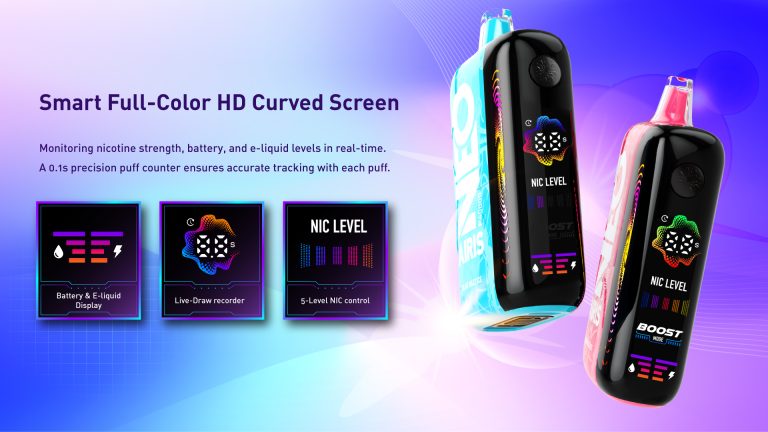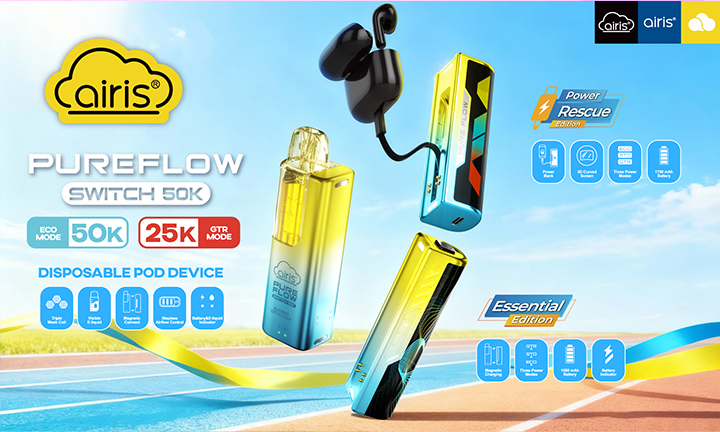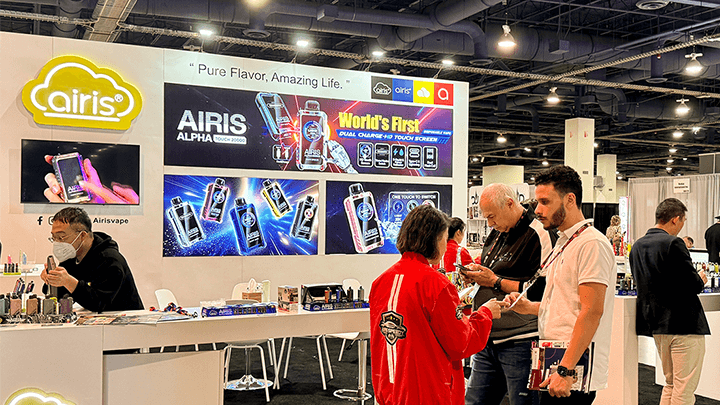WARNING:This product contains nicotine.Nicotine is an addictive chemical.
How Long to Charge a Vape? (2025 Expert Guide for Disposable, Pod, and Mod Vapes)
Author: Airis Tech Team • Updated: 2025
This expert guide explains charging time ranges for different vape types, how to recognize when a disposable needs charging, safety best practices, and practical tips to extend battery lifespan.
1. Introduction: Why Charging Time Matters
Knowing how long to charge your vape affects three things that matter to users and professionals alike: safety, battery lifespan, and consistent performance. Undercharging leads to reduced vapor and flavor; overcharging (or using poor chargers) can accelerate battery degradation or create safety risks. This guide explains practical charging times by device type and provides evidence-based tips to maximize both safety and service life.
For basic battery science behind why charging behavior matters, see Battery University’s primer on lithium-ion battery care. Battery University — How to Prolong Lithium-Based Batteries.
Related: Vape Safety Tips for Beginners.
2. Average Vape Charging Times by Type
The table below summarizes typical charging times for common vape categories. Actual times depend on battery capacity (mAh), internal charge circuitry, and the charger’s output current (amps).
| Vape Type | Average Charging Time | Typical Battery Capacity | Charging Port | Notes / Examples |
|---|---|---|---|---|
| Disposable Vape | 30–60 minutes | 400–800 mAh | Type-C or Micro-USB (if rechargeable) | Many disposables are non-rechargeable — rechargeable models vary. See our High-Capacity Disposable Vapes guide. |
| Pod System | 45–90 minutes | 800–1,200 mAh | Type-C | Modern pod devices (e.g., Airis PuriPod SE) typically charge fastest. |
| Box Mod (internal battery) | 1.5–3 hours | 1,500–3,000 mAh | USB-C or external charger for 18650/21700 cells | Dual-cell mods may take longer; use manufacturer-recommended chargers. |
| High-Capacity Disposable | 1–2 hours | 850–1,000+ mAh | Type-C | Examples include high-puff-count products such as the Airis Neo-P40000. |
Note: these are typical ranges. If you know the device’s battery mAh and the charger’s current (A), approximate charge time ≈ (battery mAh ÷ 1000) ÷ charger current (A) × 1.2 (to account for charging inefficiency).
3. Signs Your Disposable Vape Needs Charging
This is a often overlooked but high-intent area: many users don’t realize rechargeable disposables exist — and they miss clear early signals of low power. Below are typical symptoms, their likely causes, and what to do next.
| Symptom | Possible Cause | Immediate Action |
|---|---|---|
| Blinking or flashing LED | Battery is critically low or battery circuit detects fault | Connect to charger if the device is rechargeable; otherwise replace. |
| Very weak or no vapor | Battery depleted; power output insufficient | Attempt to charge; if no response, discard if non-rechargeable. |
| Delayed or soft hit | Battery voltage sag under load | Charge soon to avoid burnt wicking or poor flavor. |
| Device not responding when puffing | Fully discharged or internal protection triggered | Try charging for 10–15 minutes; inspect cable/port for damage. |
If you see repeated failures to charge (no LED, no response), stop using the device and follow manufacturer guidance. For troubleshooting a disposable that’s not hitting, see How to Fix a Disposable Vape That’s Not Hitting.
For general consumer guidance on which disposables are rechargeable and how they differ, Healthline provides a helpful consumer overview: Are Disposable Vapes Rechargeable? — Healthline.
4. How to Know Your Vape Is Fully Charged
Different manufacturers indicate a full charge differently. Common indicators:
- Single solid LED color (changes from red/amber to green/white).
- Battery percentage or icon on screen (pod systems and mods).
- Auto-cutoff — the device’s charging circuit stops current when full.
Mini-table — common indicator meanings:
| Indicator | Typical Meaning |
|---|---|
| Flashing red | Charging — battery low |
| Solid green/white | Fully charged |
| No light on attempt | Possible dead battery or faulty cable/port |
If in doubt, disconnect the charger after the indicator shows full and let the device rest a few minutes — many modern devices include charge management ICs that prevent harmful overcurrent once full.
For a product-level comparison of Airis devices and how they indicate charge state, see our Airis Product Comparison Chart.
5. What Happens If You Overcharge a Vape
“Overcharging” used to be a justified fear with older chemistries. Modern lithium-ion systems typically include protective circuitry that prevents continuous overcharge. Still, consistent improper charging practices accelerate wear:
- Increased internal resistance → reduced capacity over months.
- Higher operating temperatures → potential safety risk in extreme cases.
- Reduced cycle life when batteries are regularly charged to 100% or kept at high voltage for long durations.
Most reputable devices incorporate automatic cutoff and thermal protection. For an authoritative standard and testing guidance on battery safety, refer to UL (Underwriters Laboratories). UL Battery Safety.
6. Fast Charging Tips & Myths Debunked
Myth: Fast charging always damages vape batteries.
Reality: Properly designed devices and chargers implement controlled current profiles. Charging at higher current (e.g., 5V/2A) shortens the time to full charge but quality of the charger and the device’s charge management are what determine long-term effect.
Practical recommendations
- Use the manufacturer-supplied cable and charger when possible.
- Avoid unknown “fast chargers” with high voltage that aren’t USB PD/standard compliant.
- Typical safe charging range for small vape batteries: 5V, up to 2A (check device documentation).
Related reading: Can You Use a Fast Charger for Your Vape?
7. How to Extend Vape Battery Lifespan
Follow these practical, experience-backed tips to extend service life:
- Avoid charging to 100% every time. For long-term storage, keep batteries around 40–60%.
- Do not routinely discharge to 0%. Shallow discharge cycles are better for longevity.
- Keep batteries cool. Avoid charging or storing devices in hot cars or direct sunlight.
- Use high-quality cables and chargers. Damaged cables can produce voltage drops and heating.
- Perform periodic inspections. Look for port corrosion, bent pins, or heat damage.
For official guidance on safe disposal and environmental considerations for lithium batteries, see the EPA: EPA — Used Lithium-Ion Batteries.
8. Vape Charging Safety Checklist
| Do | Don’t |
|---|---|
| Use the original or manufacturer-recommended charger and cable | Charge on soft surfaces (bed, couch) or near flammable material |
| Unplug after the device indicates a full charge | Use frayed or damaged cables |
| Store devices at moderate state of charge for long periods | Leave charging unattended for extended periods in unsafe environments |
| Follow the manufacturer’s charging instructions and warnings | Attempt to open or modify battery cells or sealed disposables |
See also our comprehensive Vape Safety Guide for additional best practices and incident prevention tips.
9. FAQ: Common Vape Charging Questions
How long does it take to charge a disposable vape?
If the disposable is rechargeable, typical times are 30–60 minutes depending on capacity and charger. If the product is non-rechargeable, it cannot be charged and should be discarded after use.
Can I charge a vape overnight?
Occasional overnight charging on a high-quality, certified charger is unlikely to cause immediate harm for devices with proper charge management. However, as a precaution and to maximize battery lifespan, avoid leaving devices charging unattended for prolonged periods.
Why is my vape not charging?
Common causes: damaged cable, dirty/blocked charging port, depleted or faulty battery, or internal protection has been triggered. Try a known-good cable and charger first; if still not charging, stop using the device and contact the manufacturer.
How can I charge a vape without its original charger?
Only use a charged USB power source that matches the device’s required voltage/current and is from a reputable manufacturer. Preferably use a short, high-quality cable and avoid non-compliant fast chargers. When possible, obtain a manufacturer-approved replacement.
10. Conclusion & Recommended Products
Following proper charging practices improves both safety and battery longevity. Use manufacturer-approved cables, avoid extreme temperatures, and pay attention to the device’s charge indicators. For users who want reliable, fast-charging rechargeable disposables or pod devices, we recommend the following Airis products:
Airis Neo-P40000
Flagship high-capacity rechargeable disposable — long puff count, Type-C charging.
Airis PuriPod SE
Daily pod system with fast charge and consistent output — ideal for everyday use.
Explore our full collection of rechargeable disposables: Rechargeable Disposable Vapes by Airis







